Nagoya Kembutsu (Sightseeing)
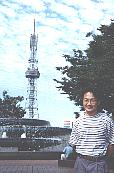 This was my first time in Nagoya,
and Mike had forgotten his Lonely Planet guidebook,
so (despite Mike's acrophobia) we headed for the top of the tallest structure we could see,
the TV Tower to get our bearings.
This was my first time in Nagoya,
and Mike had forgotten his Lonely Planet guidebook,
so (despite Mike's acrophobia) we headed for the top of the tallest structure we could see,
the TV Tower to get our bearings.
Old Nagoya was almost completely destroyed during World War Two,
so the streets of the rebuilt city could be made straight and wide.
In particular, there is a main French- or Spanish-inspired boulevard
with a park-like median with lots of places to hang out, like this
James Dean / Elvis /
Leningrad Cowboys Kurabu (Club) was doing
(below).
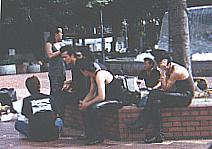
I think they were getting ready to do a
group dance in public, Harajuku-style.
I wondered if they would beat me up if I took their picture,
but Mike pointed out that was probably precisely what they wanted me to do,
given that they had set up their own video camera to record their performance!
Nagoya-jo
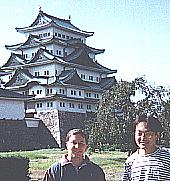
Nagoya-jo was a short, easy walk up the boulevard.
The castle is surrounded by a beautiful, expansive garden.
Deer were grazing in the dry, overgrown moat. Like most castles in Japan,
the interior has been converted into a museum.
This one featured feudal period armour, including some beautiful kabuto (helmets).
One had an insignia that looked suspiciously similar to a Nike "swoosh"!
There were also some new interactive displays, like a "pull the rock" simulator
that recreates what it was like to build the castle foundation.
We met for supper at an izakaya-style restaurant with Mizue (second from right)
and her friend. Mizue spent a year and a half in Edmonton AB studying English and is now
putting her skills to use assisting the many foreigners living in Nagoya.
 We finished off the evening in a wine bar. The popularity of
(grape -- as opposed to rice) wine is growing in Japan,
but the process of educating the buying public still has a long way to go.
The task of picking our bottle was left up to me. Luckily
I made a selection that was to everyone's liking (an Italian pinot grigio)!
We finished off the evening in a wine bar. The popularity of
(grape -- as opposed to rice) wine is growing in Japan,
but the process of educating the buying public still has a long way to go.
The task of picking our bottle was left up to me. Luckily
I made a selection that was to everyone's liking (an Italian pinot grigio)!
Travel Tip: Don't visit Nagoya on a Monday -- almost all of the tourist attractions are closed, including the Tokugawa Bijutsukan (Art Gallery) (I'll have to settle for a virtual tour!). Mizue and I were left with two choices: One option was Meiji-mura (Meiji Village), a historical park showing what Japan was like when it first became Westernized in the late 1800s. I figured I could see Victorian buildings just as easily in Canada, so I suggested that we go to Arimatsu instead.
Arimatsu
A short ride on one of the unusual-looking trains of the private Meitetsu Railways brought us to Arimatsu. Since the time of the shogun, this small town has been famous for the craft of shibori, a technique for resist-dying fabrics. Most of the workshops are found close to the train station along a street lined with beautiful old houses.
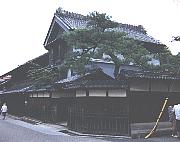

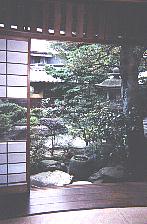
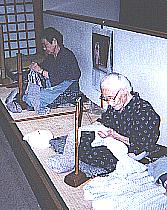
Shibori
Shibori is tie-dye taken to a minutely detailed, labour intensive extreme. One of the shops had an excellent interpretive centre, where one can view a video of the whole process and see artisans at work tying the stenciled cloth in preparation for the dye. The 92-year-old lady in the foreground has been doing shibori since she was a teenager, and joked about working alongside an upstart "youngster" (the 70-year-old lady in the background)!
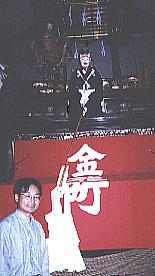
Karakuri ningyo (mechanical puppets)
Another point of interest in Arimatsu are the karakuri ningyo, mechanical puppets mounted atop two-storey-high floats that are pulled through the streets as part of the town's June matsuri (festival). The floats stop at street corners, and puppeters housed inside the floats make the puppets dance, perform Shinto rites, and even write kanji! During the rest of the year, one of the floats can be viewed at the building where it is stored, along with a video of the festival. The puppet innards represent the beginnings of automation technology in Japan.
|
Local Food
kishimen (flat noodles in a clear broth), tenmusu (bite-sized onigiri - rice balls - with a tempura shrimp in the centre), ebi furai (battered fried shrimp), and anything with miso (soybean paste)! |
